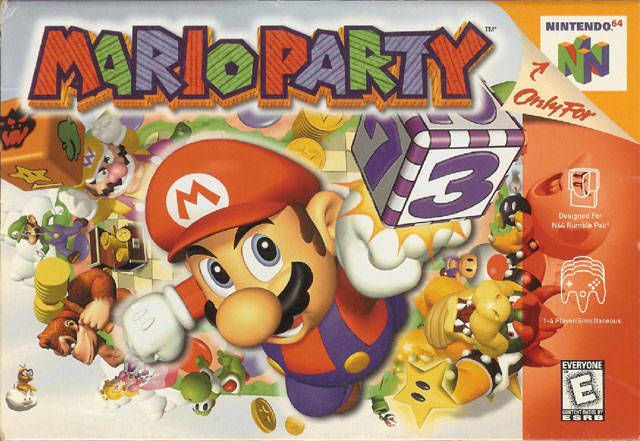
|
| Developer: Hudson Soft |
| Publisher: Nintendo |
| Released: February 8 1999 |
| Regions: NA, PAL, JP |
| Genre: Board |
| Multiplayer: 1-4 players |
| Cart Size: 32MB / 256Mbits |
| Saving: On-Cart |
| Rumble Pak?: Yes |
| Expansion Pak? No |
| - Required? No |
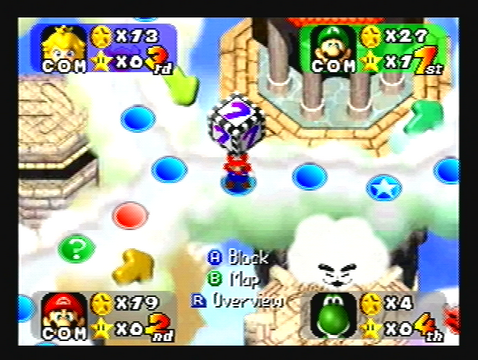
|
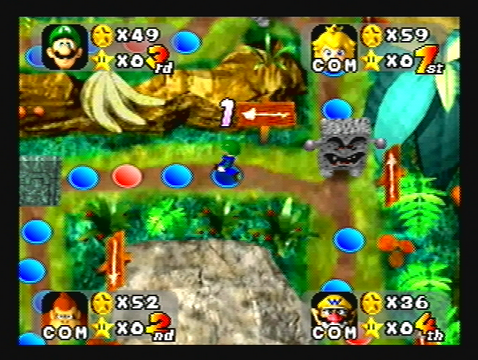
|
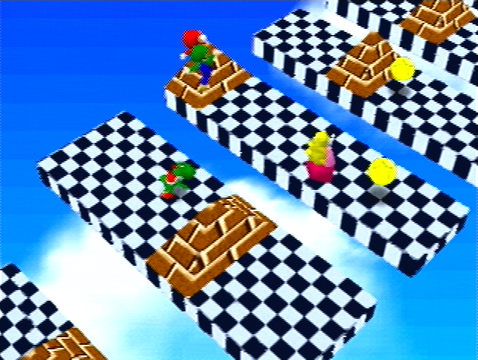
|
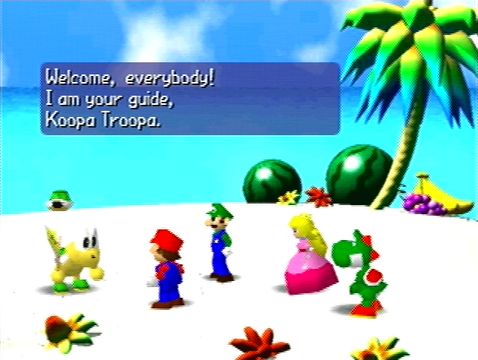
|
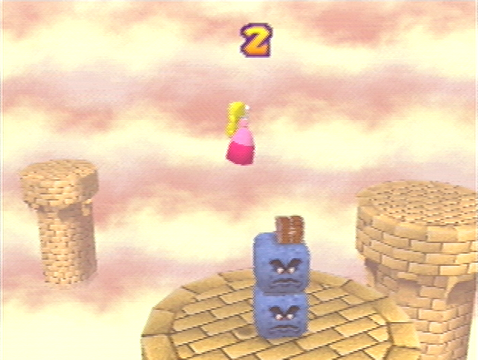
|
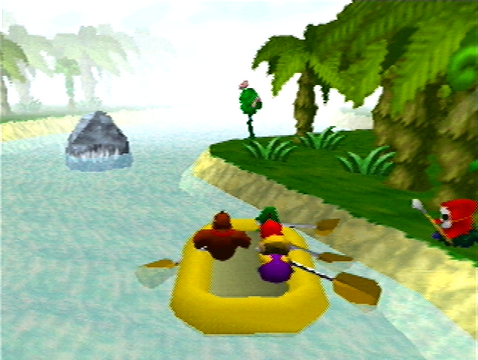
|
Nintendo's first game designed to sell replacement controllers
Multiplayer games were groundbreaking on the N64, without a doubt. With the system's 4 built-in controller ports, the many 3 or more player games truly created a phenomenon, one that helped lead up to the dawn of internet-connected multiplayer. We here at Micro-64 haven't really looked at very many games with strong multiplayer modes yet, so we felt a great place to begin was with Mario Party. This game, while not the first successful N64 game designed to be played with multiple people, was certainly among the best of such games. It was a brand new series for Nintendo, but still built upon a pre-existing IP, that being Mario. This trend continued ever since, but Mario Party remains great despite the eventual Mario saturation. Up until that point, party / board games still weren't that common. There were various licensed board games as well as the occasional "party" like game, but Mario Party seemed to bring the idea of a virtual board game into mainstream attention. After the release of Mario Party, the idea of spin-off games for well known IPs aimed at casual gamers started to grow, and eventually bloomed with the release of the Nintendo Wii. Yet, an extensive legacy doesn't always guarantee that the original game was any good. That's what this review is for.
Mario Party is, at its heart, a board game. 1 to 4 players, human or computer controlled, hit a dice block, go around blue, red and other types of spaces, various events sometimes occur and a mini-game is played. At times it's somewhat reminiscent of Monopoly type board games, but thanks to its digital format, Mario Party is capable of things no board game could ever hope to have. Right from the beginning, the biggest feature Mario Party had was mini-games. These usually appeared whenever all 4 players had taken a turn around the board. If any of the players won, they'd receive 10 coins. Sometimes everyone could win coins, depending on the mini-game. There were several types of mini-games, such as 4-player, 2 vs 2, 1 vs 3 and 1 player, but all shared basic principles. Several characters from the Mario-verse are playable, such as Mario, Luigi, Yoshi, Peach, Wario and Donkey Kong. Toad acts as the host of the game and even Bowser makes an appearance. He's essentially the antagonist as he only ever causes pain and misery during a party game.
When playing a standard round of Mario Party, the eventual goal is to accumulate as many stars as possible. The player with the most stars (and coins if two or more players have the same number of stars) is declared the Super Star, and therefore the winner. Coins are used to buy stars, as well as buy items, pay tolls and serve other functions depending on the board. Each board has its own features and theme (each one is dedicated to one of the 6 playable characters), but they all share core elements with each other, such as an item shop to buy things. Colored spaces dot each board. There are blue spaces, which give you 3 coins for landing on them, red ones which deduct 3 coins, happening spaces (marked with a ?) which are context and board specific, Bowser spaces which usually result in lost coins or stars, the mini-game space where one player plays a mini-game to win coins and various other kinds of spaces. Mario Party offers a convenient in-game tutorial which can more fully explain the rules, along with visual aids.
From the main menu, there are quite a few ways to play Mario Party. The main attraction of Mario Party is the adventure mode, where up to 4 players compete for coins and stars. In this mode, any coins and stars you collect can be used to purchase items at the Mushroom Shop, or buy mini-games at the Mini-Game House.
There's the aforementioned mini-game house, where individual mini-games can be played without having to use a board. To play them as is, you actually have to pay for them, using coins earned during adventure mode. Although replay ability is typically a good thing, making the player buy (rather expensive) mini-games is an awfully cruel means of adding length to the game.
One of the more interesting modes is Mini-Game Island. This is a single player game that focuses primarily on mini-games and arranges them in an adventure fashion, where they must all be completed in order to win. This is the only strictly single player mode in Mario Party. This was before a story mode was invented.
The other modes and menus include the previously mentioned Mushroom Shop, Mushroom Bank, where stars and coins are kept and any mushroom shop items are selected for use, and the Option House, which is where general game settings are located. Lastly, tucked away inside the Mini-Game House is the Mini-Game Stadium. This is like a party game mixed with Mini-Game Island, where in multiple players compete against each other strictly using mini-games.
Although sometimes a matter of contention, the mini-games are essentially the bread and butter of Mario Party. They comprise much of what makes Mario Party more of a video game than a board game. Given there weren't many other mini-game based titles prior to Mario Party, let alone ones that had as many mini-games, it's quite impressive that Hudson Soft crafted such a well rounded assortment of games. It has its rough edges but overall the list of mini-games is mostly littered with quality games. There are ones that hardly ever get old, such as Mushroom Mix-up, Mario Bandstand, Shy Guy Says and Face Lift. Other challenging games like Skateboard Scamper, both Slot Car Derbys, Piranha's Pursuit and Tug o' War are also fun. Compared to future Mario Party installments, the mini-game selection is small, the 2 vs 2 mini-games are barely represented and luck-based games had yet to make an appearance, but being the first in the series, Mario Party 1 can be excused. The 1 player mini-game concept slowly died off with each successive Mario Party sequel.
This brings us to one of Mario Party's unfortunate faults. Excessive difficulty in some mini-games and wanton destruction of controllers. While the computer controlled opponents aren't often that hard to overcome in either party games or mini-games, the mini-games themselves were not designed with casual or moderate gamers in mind. Most of them require a decent amount of skill and practice to be any good at. Just try beating Mini-Game Island; it isn't an easy task at all. Some of the mini-games require the player to rotate the control stick very fast. The worst offenders of control stick abuse include Tug o' War, Cast-A-Ways, both Slot Car Derbys and Pedal Power. Hudson Soft must not have used real N64 controllers during planning and testing, because doing this (and other violent control stick movements often used in Mario Party) causes the stick to wear out very fast. There's even a Mecha Fly Guy in the Mini-Game Shop whose sole purpose is to gauge the player's skill at rotating the stick. Be prepared to wear out a few controllers if you intend to play Mario Party a lot.
Mario Party's graphics and visuals are, well, modest to say the least. Some sections of the game are drawn using pre-rendered backgrounds, like a lot of PlayStation games. The polygon models are usually simple with adequate textures. For a 1999 game, it could look better. Maybe fewer pre-rendered backgrounds and more detailed models. To be fair though, Mario Party doesn't necessarily need high end graphics. It is after all, a Mario game. Technically it's on the low end of the Mario catalog, being intended for more casual players than trained masters. Overall, the graphics have quite a bit of polish and hold a consistency amongst the various styles and environments. It could have been more, but what's here is certainly more than adequate.
The sound and music of Mario Party is a bit more outstanding than the graphics. Not only are there quite a few voice samples to breathe some life into the characters, but the majority of the music tracks are memorable and the sound effects are pleasantly simple and not grating to hear over and over again. Mario Party includes some familiar pieces of Mario music, along with plenty of new themes, some of which would be kept for future installments.
With all its features weighed and measured, Mario Party is most definitely a classic N64 game, but it has its rough points. On top of that, it's hard to ignore its 8 sequels. Comparatively speaking, Mario Party 1 is rather bare bones, lacking a story mode, mini-game variety and quantity and the many additional gameplay modes the Mario Party games became known for as the years went on. It may not have all those things, but then it was the first after all. It does have some objective problems, like the excessive use of the control stick in a variety of violent ways, the sometimes unforgiving mini-games, the ridiculous pay-per-mini-game racket going on in the Mini-Game House and the generally meager assortment of content. Yet, Mario Party 1 got many things right, like the excellent music and cozy (yet simple) graphics, creative and fun mini-games, the challenging Mini-Game Island, the well designed boards in the Adventure mode and a heaping helping of polish and consistent quality. Mario Party represents one of Nintendo's best (mostly) original ideas, even if that basic formula has been re-released and redesigned so many times, even the 5th installment feels tired, let alone the 9th.
Presentation: 8.5
Mario Party is infused with that classic Nintendo charm and appeal. With its simple and fun demeanor, anyone can enjoy it.
Graphics: 8.0
High grade textures, complex polygonal models and long draw distances may not describe Mario Party, it doesn't necessarily need them. The game's visual style takes advantage of simpler graphical quality. Though for 1999, Mario Party looks a bit old.
Sound: 8.5
The music and sounds ring of Mario through and through. Some classic themes and new ones have been included, along with pleasant sound effects and many voice samples.
Gameplay: 8.5
Much like other spin-off titles in the Mario franchise, Mario Party is highly playable and accessible. The various modes offer a lot of fun and challenge. Some mini-games can be too challenging though.
Lasting Appeal: 7.5
Probably Mario Party's only actual limitation, which isn't saying much honestly. While there are means of adding length to the game's content, some aren't necessary, such as adding price tags to the mini-games for individual play. Mini-Game Island and Adventure Mode help balance things though.
Overall: 8.2
Written by Aaron Wilcott
June 22 2013
|